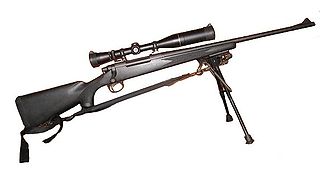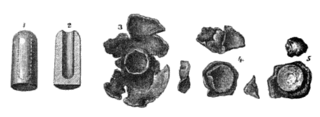
Bolt action is a type of firearm action where the handling of cartridges into and out of the weapon's barrel chamber is operated by manually manipulating the bolt directly via a handle, which is most commonly placed on the right-hand side of the weapon. When the handle is operated, the bolt is unlocked from the receiver and pulled back to open the breech, allowing the spent cartridge case to be extracted and ejected, the firing pin within the bolt is cocked and engages the sear, then upon the bolt being pushed back a new cartridge is loaded into the chamber, and finally the breech is closed tight by the bolt locking against the receiver.

The Lee–Enfield is a bolt-action, magazine-fed, repeating rifle that served as the main firearm used by the military forces of the British Empire and Commonwealth during the first half of the 20th century. It was the British Army's standard rifle from its official adoption in 1895 until 1957. The WWI versions are often referred to as the "SMLE", which is short for the common "Short Magazine Lee-Enfield" variant.

The Karabiner 98 kurz (German: [kaʁaˈbiːnɐ ˌʔaxtʔʊntˈnɔʏntsɪç ˈkʊɐ̯ts]; "carbine 98 short", often abbreviated Kar98k or K98k and often incorrectly referred to as a “K98” is a bolt-action rifle chambered for the 7.92×57mm Mauser cartridge that was adopted on 21 June 1935 as the standard service rifle by the German Wehrmacht. It was one of the final developments in the long line of Mauser military rifles. Although supplemented by semi- and fully automatic rifles during World War II, it remained the primary German service rifle until the end of the war in 1945. Millions were captured by the Soviets at the conclusion of World War II and were widely distributed as military aid. The Karabiner 98k therefore continues to appear in conflicts across the world as they are taken out of storage during times of strife.

The Remington Model 700 is a series of bolt-action centerfire rifles manufactured by Remington Arms since 1962. It is a development of the Remington 721 and 722 series of rifles, which were introduced in 1948. The M24 and M40 military sniper rifles used by the US Army and USMC are both based on the Model 700 design.

The Gewehr 98 is a German bolt action rifle made by Mauser firing cartridges from a 5-round internal clip-loaded magazine. It was the German service rifle from 1898 to 1935, when it was replaced by the Karabiner 98k, a shorter weapon using the same basic design. The Gewehr 98 action, using a stripper clip loaded with the 7.92×57mm Mauser cartridge, successfully combined and improved several bolt action engineering concepts which were soon adopted by many other countries including the UK, Japan, and the US. The Gewehr 98 replaced the earlier Gewehr 1888 rifle as the main German service rifle and first saw combat in the Chinese Boxer Rebellion and was the main German infantry service rifle of World War I. The Gewehr 98 saw further military use by the Ottoman Empire and Nationalist Spain.

The term express was first applied to hunting rifles and ammunition beginning in the middle 19th century, to indicate a rifle or ammunition capable of higher than typical velocities. The early express cartridges used a heavy charge of black powder to propel a lightweight, often hollow point bullet, at high velocities to maximize point blank range. Later the express cartridges were loaded with nitrocellulose based gunpowder, leading to the Nitro Express cartridges, the first of which was the .450 Nitro Express.
The Sako TRG is a bolt-action sniper rifle line designed and manufactured by the Finnish firearms manufacturer, SAKO of Riihimäki. The TRG-21 and TRG-22 are designed to fire standard .308 Winchester /7.62×51mm NATO sized cartridges, while the TRG-41 and TRG-42 are designed to fire more powerful and dimensionally larger .300 Winchester Magnum (7.62×67mm) magnum and .338 Lapua Magnum (8.6×70mm) super magnum cartridges. They are available with olive drab green, desert tan/coyote brown, dark earth or black stocks, and are also available with a folding stock.

Hunting weapons are weapons designed or used primarily for hunting game animals for food or sport, as distinct from defensive weapons or weapons used primarily in warfare.
The Vetterli rifles were a series of Swiss army service rifles in use from 1869 to 1889, when they were replaced with Schmidt–Rubin rifles. Modified Vetterlis were also used by the Italian Army.
The Remington Model 30 is a US sporting rifle of the inter-war period based on the military P14/M1917 Enfield rifle action, which was manufactured for the British and US governments during World War I. Initial specimens used surplus military parts with some modifications in order to consume the stock of parts, though further modifications were made as production progressed and later rifles were produced from newly manufactured parts. Most early rifles were in the military .30-06 calibre used in the M1917 but it became available in a variety of chamberings. It was the first high-powered bolt-action sporting rifle produced by Remington.
The Armscor AK22 is a rifle that fires .22 LR with a similar exterior design to the AK-47. It is imported to the United States from the Philippines. Made by Armscor. There were two versions one with a fixed wood buttstock and the second has a side folding stock.
TOZ rifles are a family of .22 Long Rifle bolt-action cadet rifles manufactured by the Tula Arms Plant. Most notably the TOZ-8, TOZ-17 and TOZ-78 which were used to train generations of Russian military, paramilitary and police cadets.
The CZ-550 is a bolt-action hunting rifle series manufactured by Česká zbrojovka Uherský Brod. The CZ 550 series is available with a medium or magnum sized action. The CZ 550 rifle resembles the Mauser 98 rifle series, though it is not an exact copy.
The Mauser M 98 are a series of currently (2009) produced hunting bolt-action rifles. Though the production of the controlled-feed Mauser M 98 bolt action system for the German military ceased at the end of World War II in 1945, the production of new Mauser M 98 and M 98 Magnum rifles for civil users has been resumed in 1999 in Isny im Allgäu, Germany by Mauser Jagdwaffen GmbH, according to original drawings of 1936 and the respective Mauser patents. Mauser Jagdwaffen GmbH is a subsidiary of SIG Sauer.
The C14 Timberwolf MRSWS is a bolt-action sniper rifle built by the Canadian arms company PGW Defence Technologies Inc. In 2005 they won the contract to supply the Canadian Forces Land Command with the C14 Timberwolf MRSWS for $4.5 million.
These guns have their roots in target shooting and were designed for full-bore target shooters in an era when surplus war rifles such as the Lee–Enfield, Lee–Metford, P14 and others were used. The Musgrave facility where they were built housed a giant gunsmithing concern. RSA actions and earlier hammer-forged barrels were manufactured at Lyttelton Engineering Works.
Arsenal AD is a Bulgarian joint-stock company based in Kazanlak, engaged primarily in the manufacture of firearms and military equipment. It is Bulgaria's oldest arms supplier.

An AR-15 style rifle is a lightweight semi-automatic rifle based on the ArmaLite AR-15 design. ArmaLite sold the patent and trademarks to Colt's Manufacturing Company in 1959. After Colt's patents expired in 1977, Colt retained the trademark and is the exclusive owner of "AR-15" designation. An expanded marketplace emerged with many manufacturers producing their own version of the AR-15 design for commercial sale. They are referred to as modern sporting rifles by the National Shooting Sports Foundation, a firearms industry trade association, and by some manufacturers. Coverage of high-profile incidents where various versions of the rifle were involved often uses the shorthand AR-15.
Cadet rifles are generally .22 caliber, bolt-action rifles used by military cadets and others for basic firearms and marksmanship training. They also come in semi-automatic versions. And, they are often miniature .22 caliber versions of standard issue service rifles. Older 19th century cadet rifles were simply smaller and lighter versions of standard issue service rifles designed to fire reduced power cartridges.










